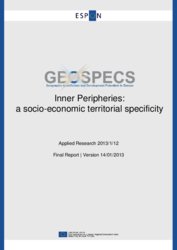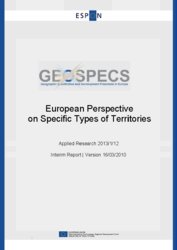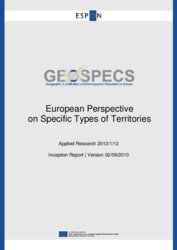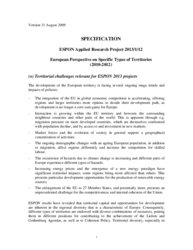GEOSPECS - Geographic Specificities and Development Potentials in Europe
Theme
European perspective on specific types of territories
Thematic scope
The EU Cohesion Policy debate has included a focus on regions with specific territorial features. The Treaty of Lisbon (2007), being in the process of ratification, mentions already some of these types of regions and territories. It states that “(...) among the regions concerned, particular attention shall be paid to rural areas, areas affected by industrial transition, and regions which suffer from severe and permanent natural or demographic handicaps such as the northernmost regions with very low population density and islands, cross-border and mountain regions. (...)”.
The Green Paper on Territorial Cohesion (2008), which launches the EU wide debate on Cohesion Policy, highlights as well the specific types of territories and regions. To better understand the strengths and weaknesses, which a specific region possesses, and to develop policies accordingly, comparable and comprehensive evidence and knowledge from a European perspective is thus in high demand for each type of region. Against this backdrop, the Green Paper holds the respective subtitle “Turning territorial diversity into strength”.
Territories with geographic specificities are characterised not only by development challenges, but also by a series of specific assets. Such assets have been identified in numerous localities and regions; knowledge about them has also, to some extent, been compiled at the European level in studies and policy perspectives on territories with geographic specificities such as those mentioned above. However, in spite of the frequent concomitant references to multiple categories of geographic specificities in policy documents, there have been no attempts to construct a transversal discourse on why they are often not fully exploited, and why many areas with geographic specificities are still “lagging”.
Please read more about the main research areas and main results envisaged on the next page.
Lead Partner
University of Geneva - Geography Department, Switzerland
Detailed information on the contracted project team can be found under Transnational Project Groups.
Sounding Board
Cliff Hague, UK
Budget: € 899 950,00
Project’s lifetime: February 2010 – December 2012
Delivery of Reports
Inception Report: 2 September 2010
Interim Report: 2 March 2011
Draft Final Report: 2 March 2012
Final Report: 1 July 2012
Publishing
Reports will be published once they are approved by the ESPON Monitoring Committee
More information
Please contact the Project Expert at the ESPON Coordination Unit:
Marjan VAN HERWIJNEN, e-mail: marjan.vanherwijnen@espon.eu
Main research areas
The main objective of the GEOSPECS project is to provide a coherent transversal framework to characterise the past trends, state and potential future developments of geographical specificities for territorial policy and regional development.
A secondary objective of this study is to facilitate the integration of this sense of commonality and of the discourses constructed to justify specific treatments, on the basis of geographic specificities, in European territorial cohesion strategies. A territorial policy perspective requires that one seeks to synthesise these various sectoral views. One may also need to construct additional conceptualisations and delineations for the purpose of territorial policy, based on the sets of objectives and operational needs specific to this field of public intervention.
Main results envisaged
- Data input based on a critical assessment of existing data to the development, update and extension of the ESPON Database by additional data on specific types of territories and regions gathered within the project, particularly in relation to the new ESPON Partner States (Iceland and Liechtenstein). Indicators need to offer compatibility with a map-making facility, to provide a consistent, homogenous, reliable, and up-datable database;
- Indicators and new complex indicators offering – as tools – additional information, particularly for monitoring purposes, on the specific types of territories and regions;
- European maps revealing the specific types of territories and regions as mentioned before (border areas, highly or sparsely populated areas, inner periphery, mountain areas, islands, coastal zones, outermost regions) and their strengths and weaknesses as well as new typologies aiming at the clustering of regions.









